Smart Meter Application: Benefits, Challenges, and Privacy Concerns
VerifiedAdded on 2020/05/11
|15
|3421
|94
Report
AI Summary
This report provides a comprehensive analysis of smart meter applications, focusing on their functionality, advantages, and disadvantages, with a specific case study in the United Kingdom. It delves into the workings of smart meters, highlighting their role in analyzing real-time energy consumption and providing insights for both suppliers and consumers. The report discusses the adoption of smart meters in the UK, including governmental initiatives and the challenges faced, such as technological limitations and public concerns. Furthermore, it explores the general, privacy, and security challenges associated with smart meters, including connectivity issues, energy dependency, potential security breaches, and the importance of safeguarding consumer data. The report also examines privacy measures, government regulations, and the steps taken to ensure the protection of customer credentials, emphasizing the importance of addressing these concerns for widespread adoption.
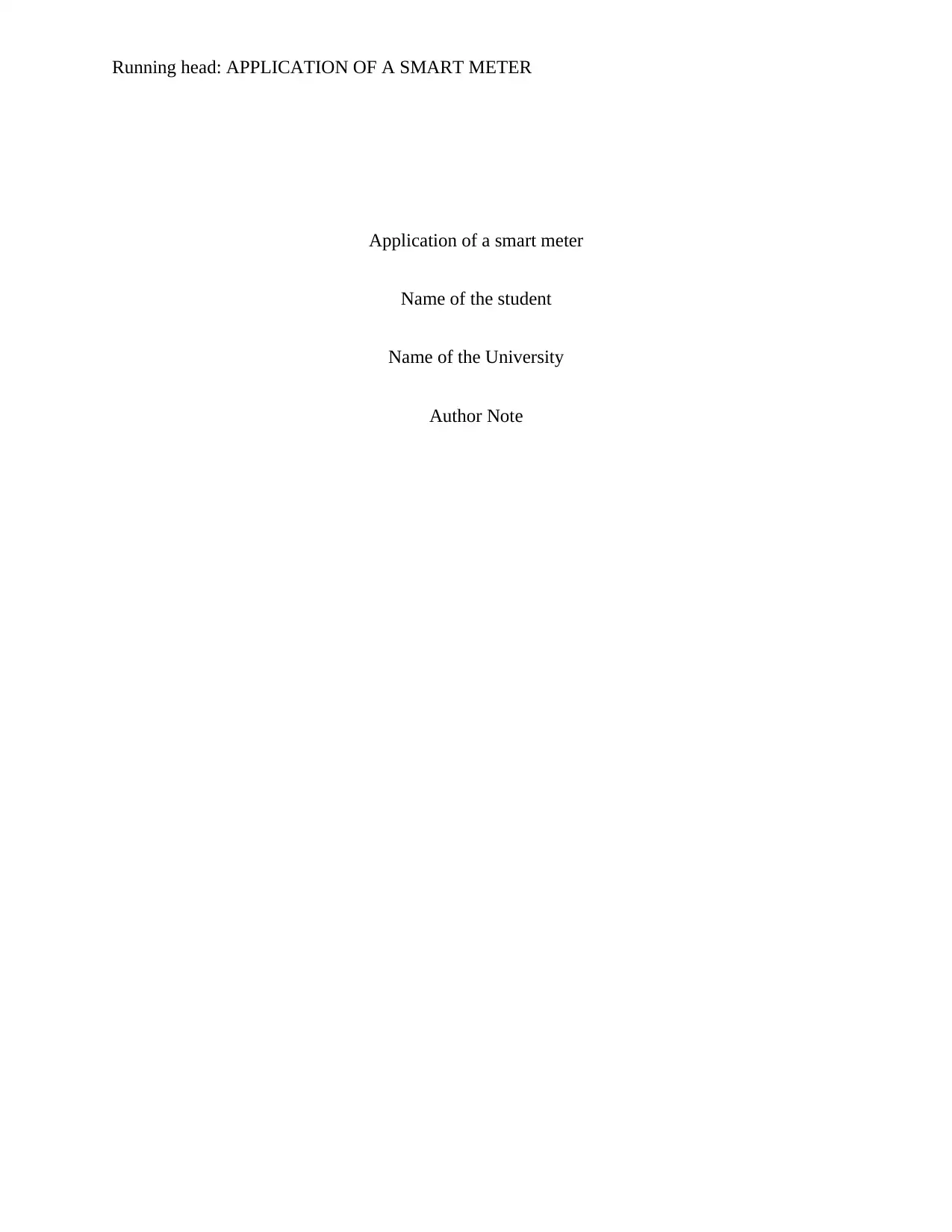
Running head: APPLICATION OF A SMART METER
Application of a smart meter
Name of the student
Name of the University
Author Note
Application of a smart meter
Name of the student
Name of the University
Author Note
Paraphrase This Document
Need a fresh take? Get an instant paraphrase of this document with our AI Paraphraser
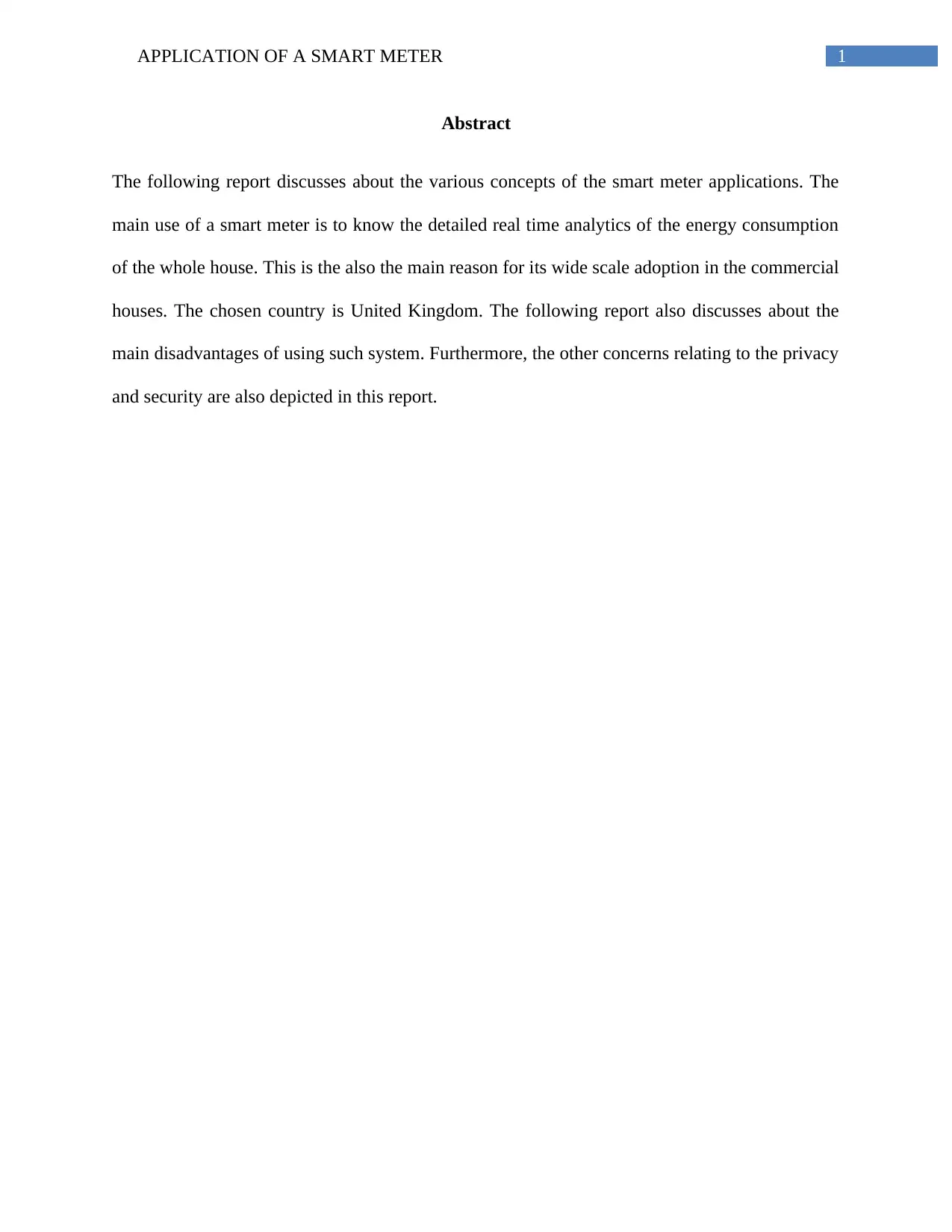
1APPLICATION OF A SMART METER
Abstract
The following report discusses about the various concepts of the smart meter applications. The
main use of a smart meter is to know the detailed real time analytics of the energy consumption
of the whole house. This is the also the main reason for its wide scale adoption in the commercial
houses. The chosen country is United Kingdom. The following report also discusses about the
main disadvantages of using such system. Furthermore, the other concerns relating to the privacy
and security are also depicted in this report.
Abstract
The following report discusses about the various concepts of the smart meter applications. The
main use of a smart meter is to know the detailed real time analytics of the energy consumption
of the whole house. This is the also the main reason for its wide scale adoption in the commercial
houses. The chosen country is United Kingdom. The following report also discusses about the
main disadvantages of using such system. Furthermore, the other concerns relating to the privacy
and security are also depicted in this report.
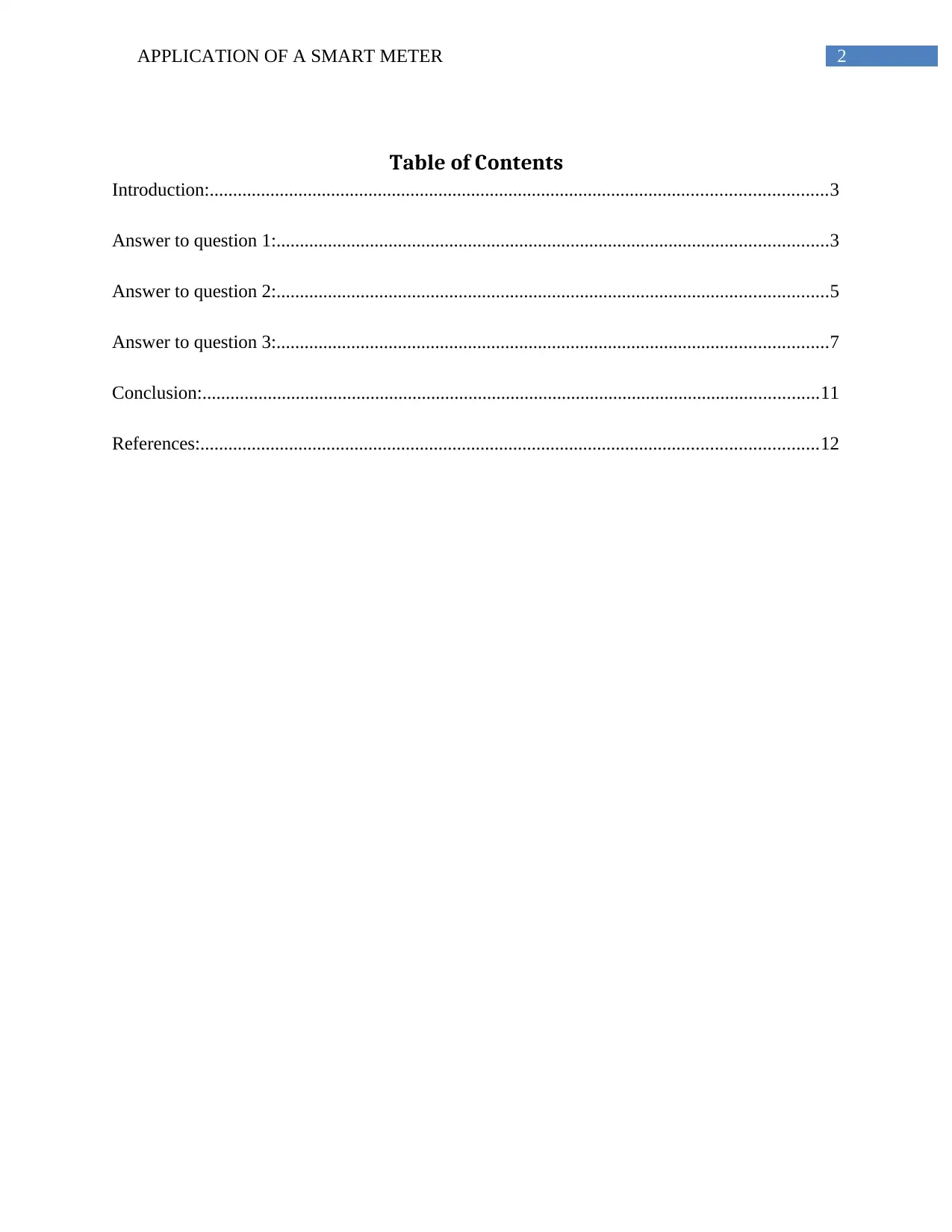
2APPLICATION OF A SMART METER
Table of Contents
Introduction:....................................................................................................................................3
Answer to question 1:......................................................................................................................3
Answer to question 2:......................................................................................................................5
Answer to question 3:......................................................................................................................7
Conclusion:....................................................................................................................................11
References:....................................................................................................................................12
Table of Contents
Introduction:....................................................................................................................................3
Answer to question 1:......................................................................................................................3
Answer to question 2:......................................................................................................................5
Answer to question 3:......................................................................................................................7
Conclusion:....................................................................................................................................11
References:....................................................................................................................................12
⊘ This is a preview!⊘
Do you want full access?
Subscribe today to unlock all pages.

Trusted by 1+ million students worldwide
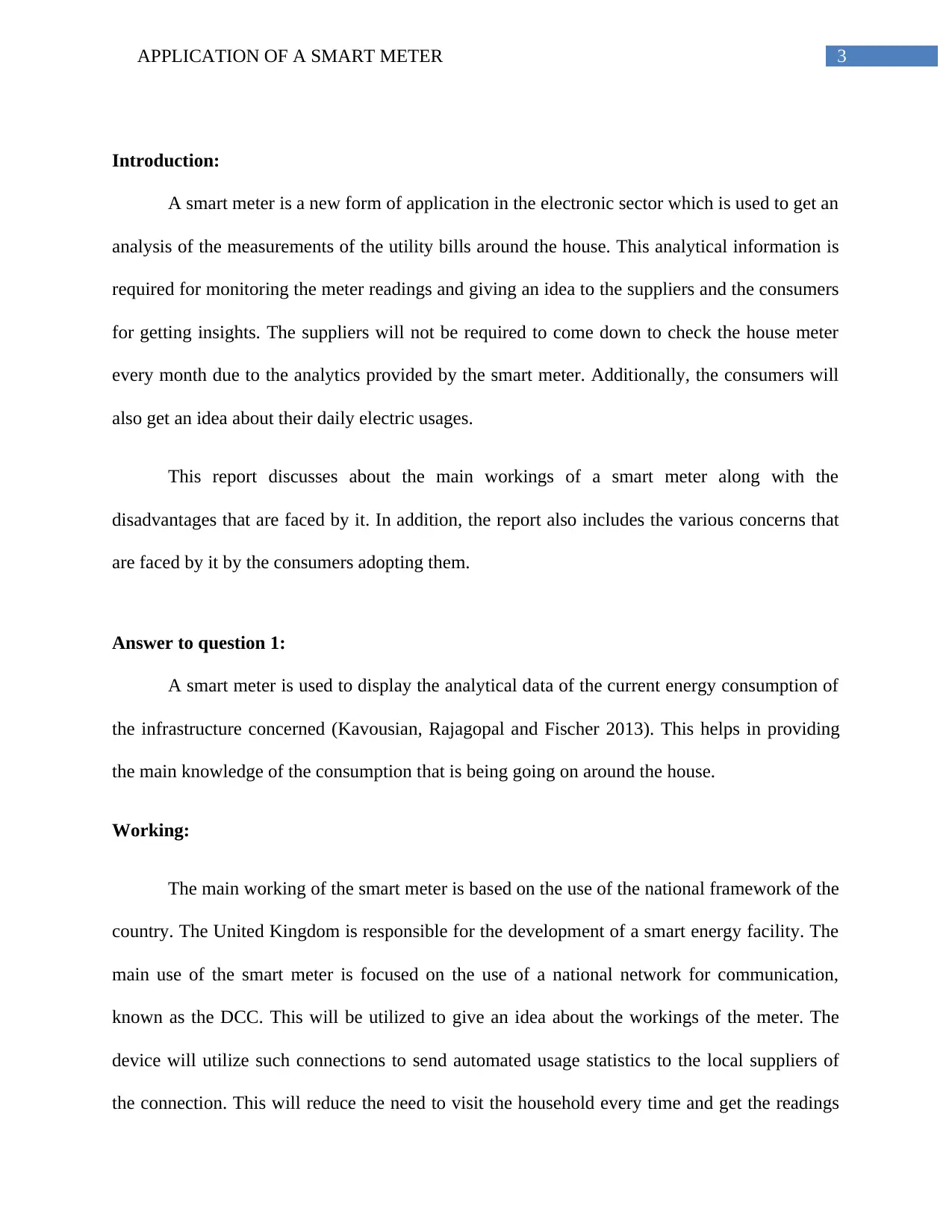
3APPLICATION OF A SMART METER
Introduction:
A smart meter is a new form of application in the electronic sector which is used to get an
analysis of the measurements of the utility bills around the house. This analytical information is
required for monitoring the meter readings and giving an idea to the suppliers and the consumers
for getting insights. The suppliers will not be required to come down to check the house meter
every month due to the analytics provided by the smart meter. Additionally, the consumers will
also get an idea about their daily electric usages.
This report discusses about the main workings of a smart meter along with the
disadvantages that are faced by it. In addition, the report also includes the various concerns that
are faced by it by the consumers adopting them.
Answer to question 1:
A smart meter is used to display the analytical data of the current energy consumption of
the infrastructure concerned (Kavousian, Rajagopal and Fischer 2013). This helps in providing
the main knowledge of the consumption that is being going on around the house.
Working:
The main working of the smart meter is based on the use of the national framework of the
country. The United Kingdom is responsible for the development of a smart energy facility. The
main use of the smart meter is focused on the use of a national network for communication,
known as the DCC. This will be utilized to give an idea about the workings of the meter. The
device will utilize such connections to send automated usage statistics to the local suppliers of
the connection. This will reduce the need to visit the household every time and get the readings
Introduction:
A smart meter is a new form of application in the electronic sector which is used to get an
analysis of the measurements of the utility bills around the house. This analytical information is
required for monitoring the meter readings and giving an idea to the suppliers and the consumers
for getting insights. The suppliers will not be required to come down to check the house meter
every month due to the analytics provided by the smart meter. Additionally, the consumers will
also get an idea about their daily electric usages.
This report discusses about the main workings of a smart meter along with the
disadvantages that are faced by it. In addition, the report also includes the various concerns that
are faced by it by the consumers adopting them.
Answer to question 1:
A smart meter is used to display the analytical data of the current energy consumption of
the infrastructure concerned (Kavousian, Rajagopal and Fischer 2013). This helps in providing
the main knowledge of the consumption that is being going on around the house.
Working:
The main working of the smart meter is based on the use of the national framework of the
country. The United Kingdom is responsible for the development of a smart energy facility. The
main use of the smart meter is focused on the use of a national network for communication,
known as the DCC. This will be utilized to give an idea about the workings of the meter. The
device will utilize such connections to send automated usage statistics to the local suppliers of
the connection. This will reduce the need to visit the household every time and get the readings
Paraphrase This Document
Need a fresh take? Get an instant paraphrase of this document with our AI Paraphraser
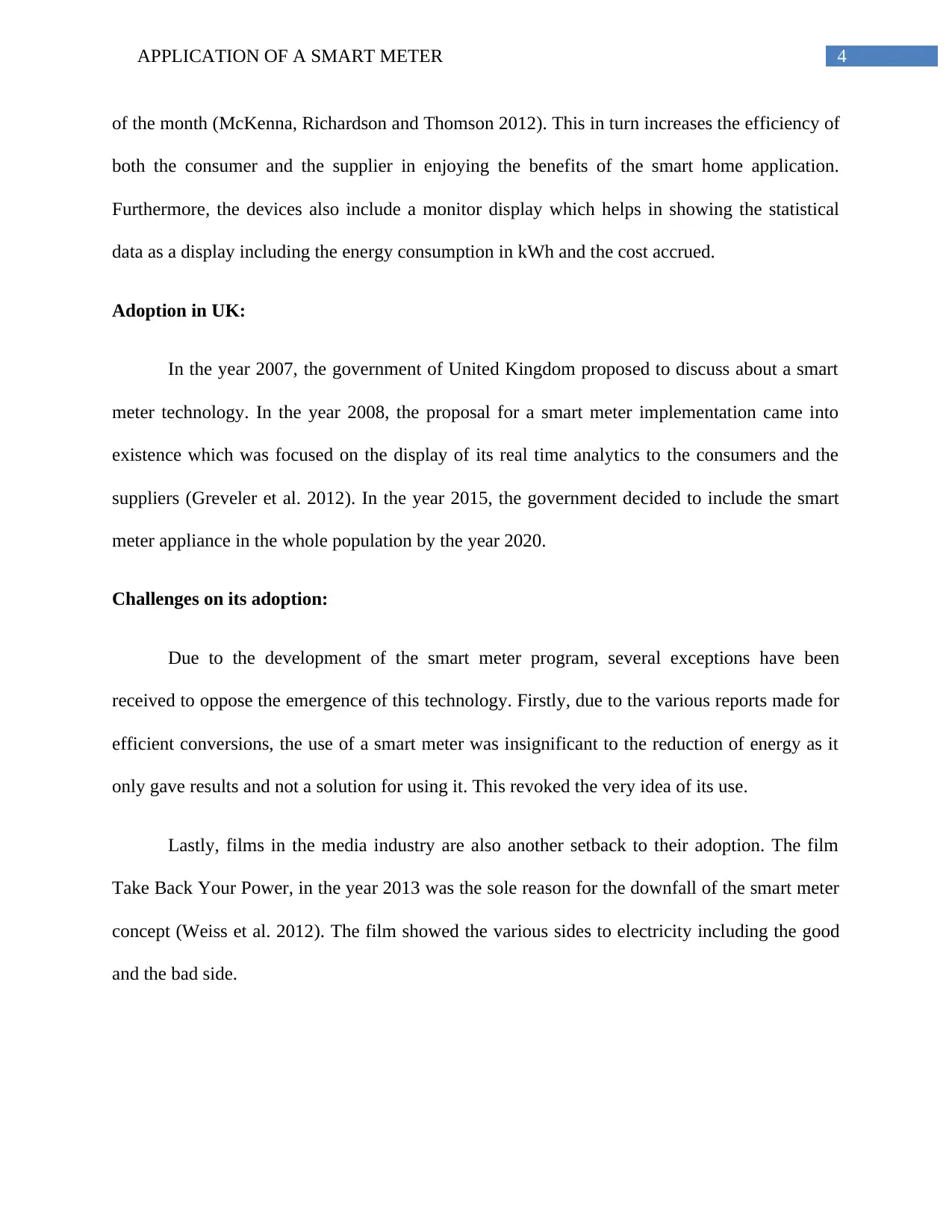
4APPLICATION OF A SMART METER
of the month (McKenna, Richardson and Thomson 2012). This in turn increases the efficiency of
both the consumer and the supplier in enjoying the benefits of the smart home application.
Furthermore, the devices also include a monitor display which helps in showing the statistical
data as a display including the energy consumption in kWh and the cost accrued.
Adoption in UK:
In the year 2007, the government of United Kingdom proposed to discuss about a smart
meter technology. In the year 2008, the proposal for a smart meter implementation came into
existence which was focused on the display of its real time analytics to the consumers and the
suppliers (Greveler et al. 2012). In the year 2015, the government decided to include the smart
meter appliance in the whole population by the year 2020.
Challenges on its adoption:
Due to the development of the smart meter program, several exceptions have been
received to oppose the emergence of this technology. Firstly, due to the various reports made for
efficient conversions, the use of a smart meter was insignificant to the reduction of energy as it
only gave results and not a solution for using it. This revoked the very idea of its use.
Lastly, films in the media industry are also another setback to their adoption. The film
Take Back Your Power, in the year 2013 was the sole reason for the downfall of the smart meter
concept (Weiss et al. 2012). The film showed the various sides to electricity including the good
and the bad side.
of the month (McKenna, Richardson and Thomson 2012). This in turn increases the efficiency of
both the consumer and the supplier in enjoying the benefits of the smart home application.
Furthermore, the devices also include a monitor display which helps in showing the statistical
data as a display including the energy consumption in kWh and the cost accrued.
Adoption in UK:
In the year 2007, the government of United Kingdom proposed to discuss about a smart
meter technology. In the year 2008, the proposal for a smart meter implementation came into
existence which was focused on the display of its real time analytics to the consumers and the
suppliers (Greveler et al. 2012). In the year 2015, the government decided to include the smart
meter appliance in the whole population by the year 2020.
Challenges on its adoption:
Due to the development of the smart meter program, several exceptions have been
received to oppose the emergence of this technology. Firstly, due to the various reports made for
efficient conversions, the use of a smart meter was insignificant to the reduction of energy as it
only gave results and not a solution for using it. This revoked the very idea of its use.
Lastly, films in the media industry are also another setback to their adoption. The film
Take Back Your Power, in the year 2013 was the sole reason for the downfall of the smart meter
concept (Weiss et al. 2012). The film showed the various sides to electricity including the good
and the bad side.
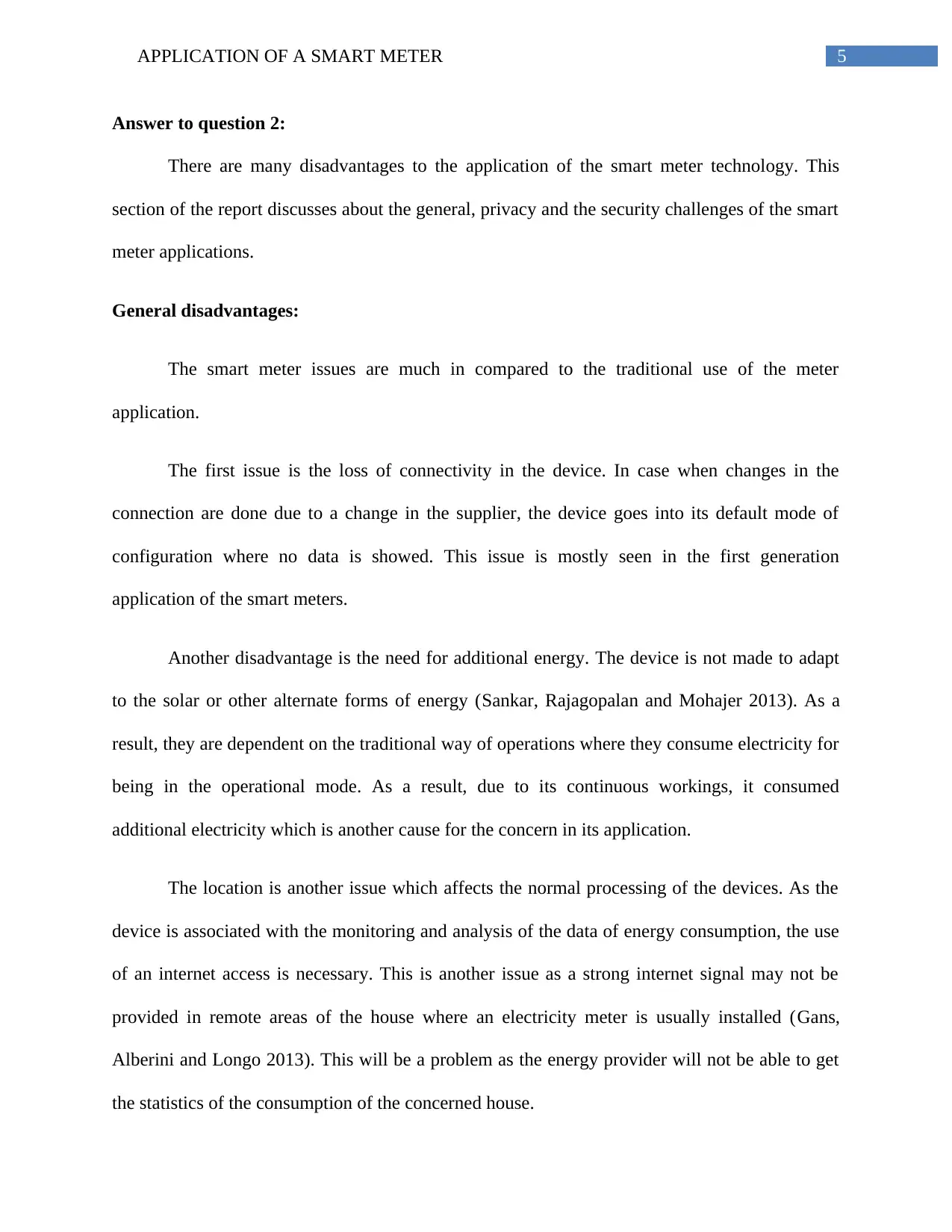
5APPLICATION OF A SMART METER
Answer to question 2:
There are many disadvantages to the application of the smart meter technology. This
section of the report discusses about the general, privacy and the security challenges of the smart
meter applications.
General disadvantages:
The smart meter issues are much in compared to the traditional use of the meter
application.
The first issue is the loss of connectivity in the device. In case when changes in the
connection are done due to a change in the supplier, the device goes into its default mode of
configuration where no data is showed. This issue is mostly seen in the first generation
application of the smart meters.
Another disadvantage is the need for additional energy. The device is not made to adapt
to the solar or other alternate forms of energy (Sankar, Rajagopalan and Mohajer 2013). As a
result, they are dependent on the traditional way of operations where they consume electricity for
being in the operational mode. As a result, due to its continuous workings, it consumed
additional electricity which is another cause for the concern in its application.
The location is another issue which affects the normal processing of the devices. As the
device is associated with the monitoring and analysis of the data of energy consumption, the use
of an internet access is necessary. This is another issue as a strong internet signal may not be
provided in remote areas of the house where an electricity meter is usually installed (Gans,
Alberini and Longo 2013). This will be a problem as the energy provider will not be able to get
the statistics of the consumption of the concerned house.
Answer to question 2:
There are many disadvantages to the application of the smart meter technology. This
section of the report discusses about the general, privacy and the security challenges of the smart
meter applications.
General disadvantages:
The smart meter issues are much in compared to the traditional use of the meter
application.
The first issue is the loss of connectivity in the device. In case when changes in the
connection are done due to a change in the supplier, the device goes into its default mode of
configuration where no data is showed. This issue is mostly seen in the first generation
application of the smart meters.
Another disadvantage is the need for additional energy. The device is not made to adapt
to the solar or other alternate forms of energy (Sankar, Rajagopalan and Mohajer 2013). As a
result, they are dependent on the traditional way of operations where they consume electricity for
being in the operational mode. As a result, due to its continuous workings, it consumed
additional electricity which is another cause for the concern in its application.
The location is another issue which affects the normal processing of the devices. As the
device is associated with the monitoring and analysis of the data of energy consumption, the use
of an internet access is necessary. This is another issue as a strong internet signal may not be
provided in remote areas of the house where an electricity meter is usually installed (Gans,
Alberini and Longo 2013). This will be a problem as the energy provider will not be able to get
the statistics of the consumption of the concerned house.
⊘ This is a preview!⊘
Do you want full access?
Subscribe today to unlock all pages.

Trusted by 1+ million students worldwide
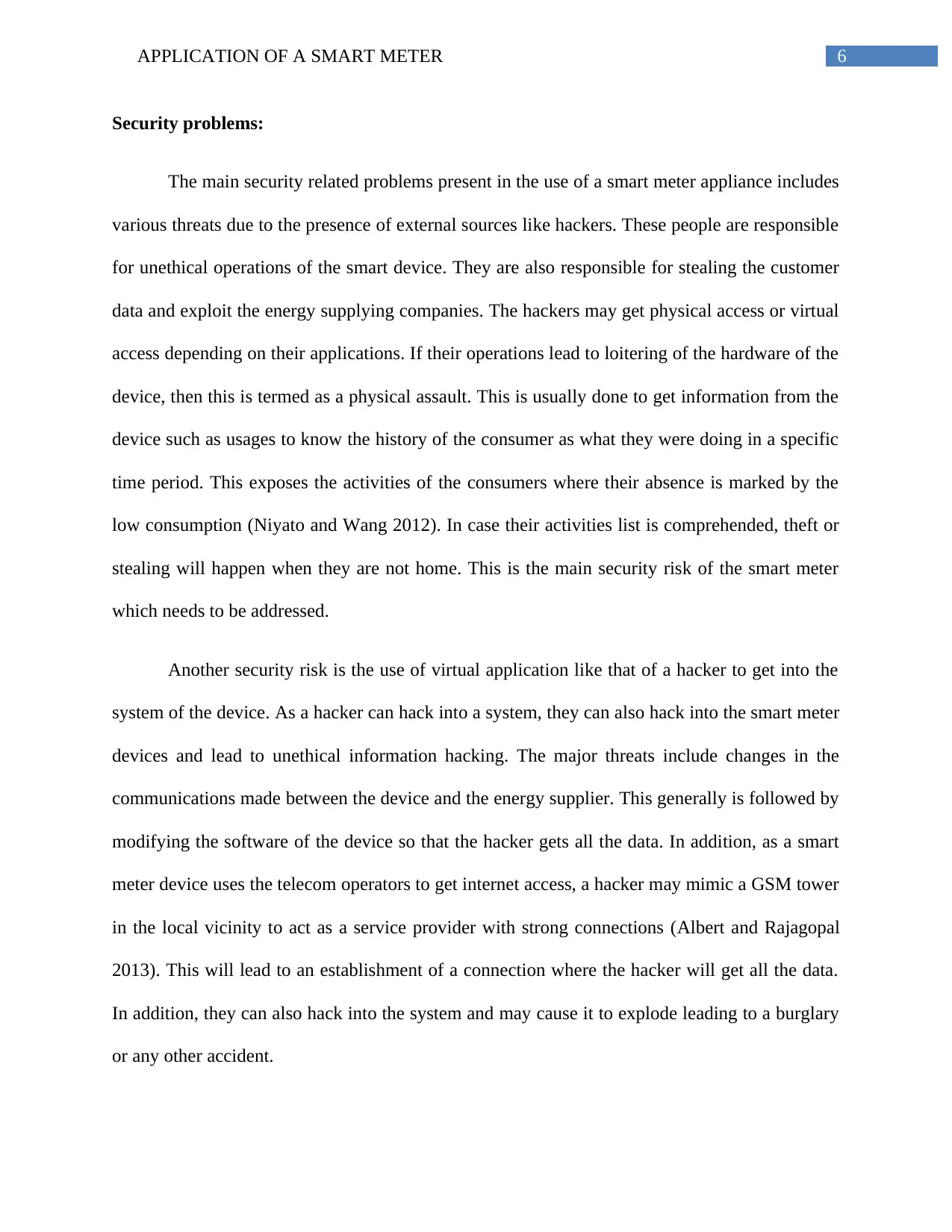
6APPLICATION OF A SMART METER
Security problems:
The main security related problems present in the use of a smart meter appliance includes
various threats due to the presence of external sources like hackers. These people are responsible
for unethical operations of the smart device. They are also responsible for stealing the customer
data and exploit the energy supplying companies. The hackers may get physical access or virtual
access depending on their applications. If their operations lead to loitering of the hardware of the
device, then this is termed as a physical assault. This is usually done to get information from the
device such as usages to know the history of the consumer as what they were doing in a specific
time period. This exposes the activities of the consumers where their absence is marked by the
low consumption (Niyato and Wang 2012). In case their activities list is comprehended, theft or
stealing will happen when they are not home. This is the main security risk of the smart meter
which needs to be addressed.
Another security risk is the use of virtual application like that of a hacker to get into the
system of the device. As a hacker can hack into a system, they can also hack into the smart meter
devices and lead to unethical information hacking. The major threats include changes in the
communications made between the device and the energy supplier. This generally is followed by
modifying the software of the device so that the hacker gets all the data. In addition, as a smart
meter device uses the telecom operators to get internet access, a hacker may mimic a GSM tower
in the local vicinity to act as a service provider with strong connections (Albert and Rajagopal
2013). This will lead to an establishment of a connection where the hacker will get all the data.
In addition, they can also hack into the system and may cause it to explode leading to a burglary
or any other accident.
Security problems:
The main security related problems present in the use of a smart meter appliance includes
various threats due to the presence of external sources like hackers. These people are responsible
for unethical operations of the smart device. They are also responsible for stealing the customer
data and exploit the energy supplying companies. The hackers may get physical access or virtual
access depending on their applications. If their operations lead to loitering of the hardware of the
device, then this is termed as a physical assault. This is usually done to get information from the
device such as usages to know the history of the consumer as what they were doing in a specific
time period. This exposes the activities of the consumers where their absence is marked by the
low consumption (Niyato and Wang 2012). In case their activities list is comprehended, theft or
stealing will happen when they are not home. This is the main security risk of the smart meter
which needs to be addressed.
Another security risk is the use of virtual application like that of a hacker to get into the
system of the device. As a hacker can hack into a system, they can also hack into the smart meter
devices and lead to unethical information hacking. The major threats include changes in the
communications made between the device and the energy supplier. This generally is followed by
modifying the software of the device so that the hacker gets all the data. In addition, as a smart
meter device uses the telecom operators to get internet access, a hacker may mimic a GSM tower
in the local vicinity to act as a service provider with strong connections (Albert and Rajagopal
2013). This will lead to an establishment of a connection where the hacker will get all the data.
In addition, they can also hack into the system and may cause it to explode leading to a burglary
or any other accident.
Paraphrase This Document
Need a fresh take? Get an instant paraphrase of this document with our AI Paraphraser
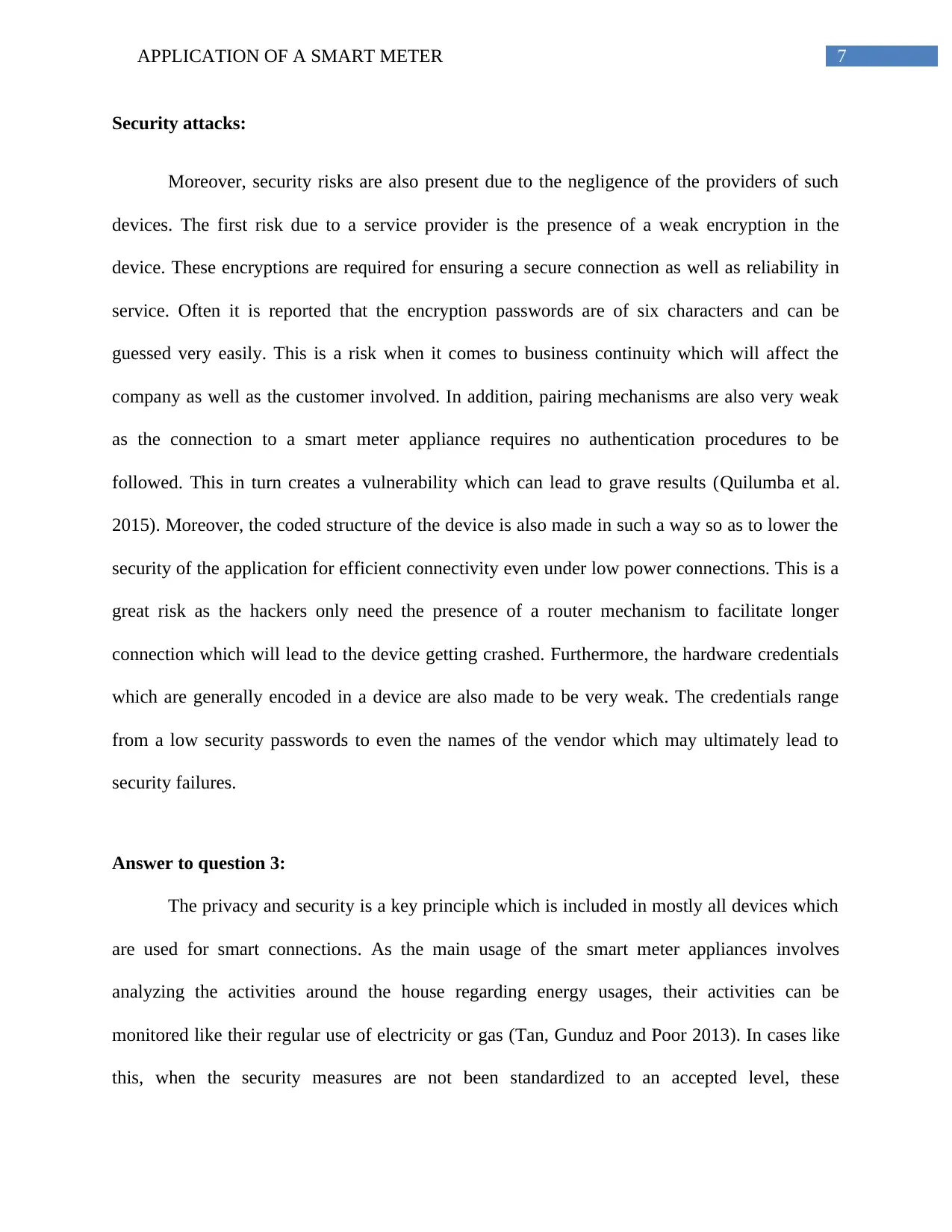
7APPLICATION OF A SMART METER
Security attacks:
Moreover, security risks are also present due to the negligence of the providers of such
devices. The first risk due to a service provider is the presence of a weak encryption in the
device. These encryptions are required for ensuring a secure connection as well as reliability in
service. Often it is reported that the encryption passwords are of six characters and can be
guessed very easily. This is a risk when it comes to business continuity which will affect the
company as well as the customer involved. In addition, pairing mechanisms are also very weak
as the connection to a smart meter appliance requires no authentication procedures to be
followed. This in turn creates a vulnerability which can lead to grave results (Quilumba et al.
2015). Moreover, the coded structure of the device is also made in such a way so as to lower the
security of the application for efficient connectivity even under low power connections. This is a
great risk as the hackers only need the presence of a router mechanism to facilitate longer
connection which will lead to the device getting crashed. Furthermore, the hardware credentials
which are generally encoded in a device are also made to be very weak. The credentials range
from a low security passwords to even the names of the vendor which may ultimately lead to
security failures.
Answer to question 3:
The privacy and security is a key principle which is included in mostly all devices which
are used for smart connections. As the main usage of the smart meter appliances involves
analyzing the activities around the house regarding energy usages, their activities can be
monitored like their regular use of electricity or gas (Tan, Gunduz and Poor 2013). In cases like
this, when the security measures are not been standardized to an accepted level, these
Security attacks:
Moreover, security risks are also present due to the negligence of the providers of such
devices. The first risk due to a service provider is the presence of a weak encryption in the
device. These encryptions are required for ensuring a secure connection as well as reliability in
service. Often it is reported that the encryption passwords are of six characters and can be
guessed very easily. This is a risk when it comes to business continuity which will affect the
company as well as the customer involved. In addition, pairing mechanisms are also very weak
as the connection to a smart meter appliance requires no authentication procedures to be
followed. This in turn creates a vulnerability which can lead to grave results (Quilumba et al.
2015). Moreover, the coded structure of the device is also made in such a way so as to lower the
security of the application for efficient connectivity even under low power connections. This is a
great risk as the hackers only need the presence of a router mechanism to facilitate longer
connection which will lead to the device getting crashed. Furthermore, the hardware credentials
which are generally encoded in a device are also made to be very weak. The credentials range
from a low security passwords to even the names of the vendor which may ultimately lead to
security failures.
Answer to question 3:
The privacy and security is a key principle which is included in mostly all devices which
are used for smart connections. As the main usage of the smart meter appliances involves
analyzing the activities around the house regarding energy usages, their activities can be
monitored like their regular use of electricity or gas (Tan, Gunduz and Poor 2013). In cases like
this, when the security measures are not been standardized to an accepted level, these
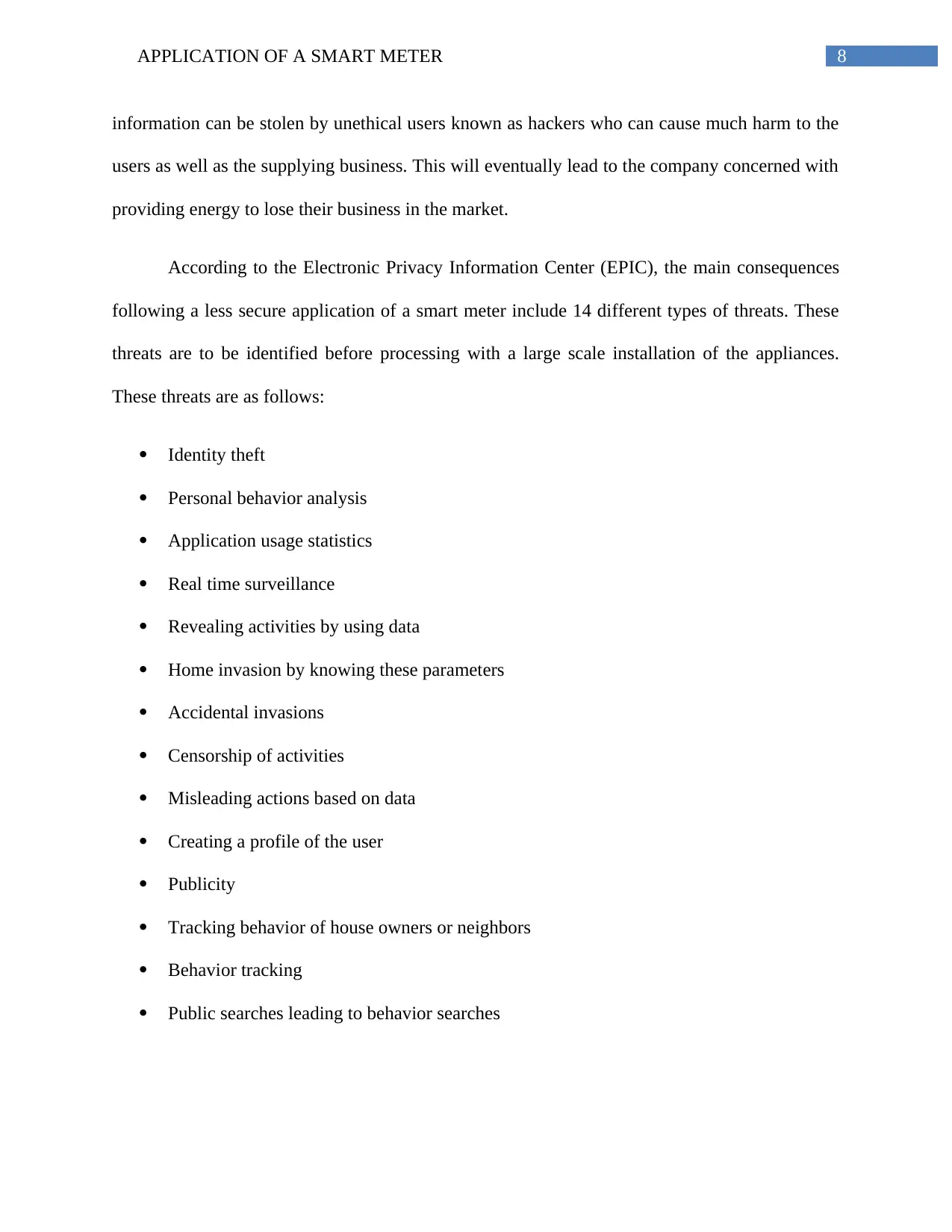
8APPLICATION OF A SMART METER
information can be stolen by unethical users known as hackers who can cause much harm to the
users as well as the supplying business. This will eventually lead to the company concerned with
providing energy to lose their business in the market.
According to the Electronic Privacy Information Center (EPIC), the main consequences
following a less secure application of a smart meter include 14 different types of threats. These
threats are to be identified before processing with a large scale installation of the appliances.
These threats are as follows:
Identity theft
Personal behavior analysis
Application usage statistics
Real time surveillance
Revealing activities by using data
Home invasion by knowing these parameters
Accidental invasions
Censorship of activities
Misleading actions based on data
Creating a profile of the user
Publicity
Tracking behavior of house owners or neighbors
Behavior tracking
Public searches leading to behavior searches
information can be stolen by unethical users known as hackers who can cause much harm to the
users as well as the supplying business. This will eventually lead to the company concerned with
providing energy to lose their business in the market.
According to the Electronic Privacy Information Center (EPIC), the main consequences
following a less secure application of a smart meter include 14 different types of threats. These
threats are to be identified before processing with a large scale installation of the appliances.
These threats are as follows:
Identity theft
Personal behavior analysis
Application usage statistics
Real time surveillance
Revealing activities by using data
Home invasion by knowing these parameters
Accidental invasions
Censorship of activities
Misleading actions based on data
Creating a profile of the user
Publicity
Tracking behavior of house owners or neighbors
Behavior tracking
Public searches leading to behavior searches
⊘ This is a preview!⊘
Do you want full access?
Subscribe today to unlock all pages.

Trusted by 1+ million students worldwide
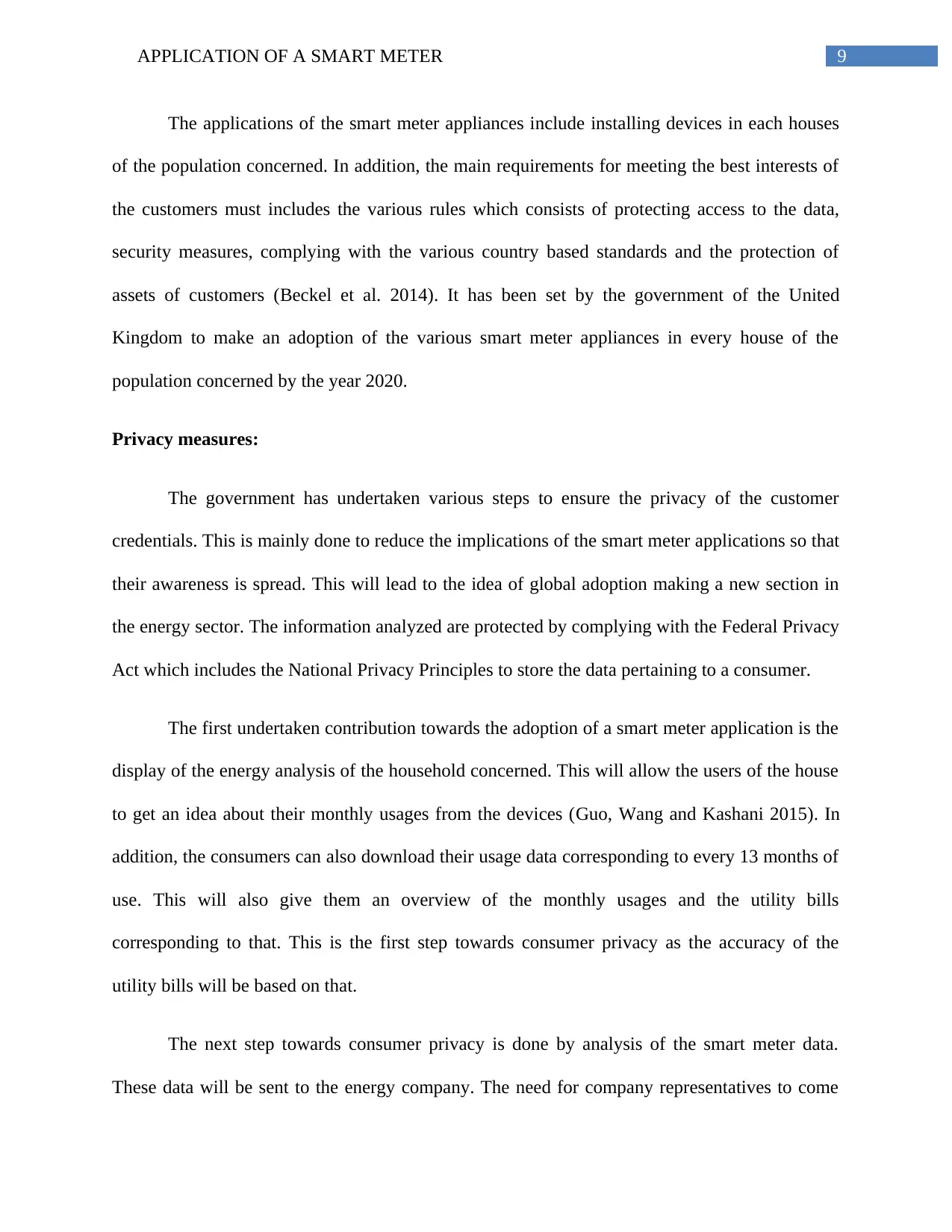
9APPLICATION OF A SMART METER
The applications of the smart meter appliances include installing devices in each houses
of the population concerned. In addition, the main requirements for meeting the best interests of
the customers must includes the various rules which consists of protecting access to the data,
security measures, complying with the various country based standards and the protection of
assets of customers (Beckel et al. 2014). It has been set by the government of the United
Kingdom to make an adoption of the various smart meter appliances in every house of the
population concerned by the year 2020.
Privacy measures:
The government has undertaken various steps to ensure the privacy of the customer
credentials. This is mainly done to reduce the implications of the smart meter applications so that
their awareness is spread. This will lead to the idea of global adoption making a new section in
the energy sector. The information analyzed are protected by complying with the Federal Privacy
Act which includes the National Privacy Principles to store the data pertaining to a consumer.
The first undertaken contribution towards the adoption of a smart meter application is the
display of the energy analysis of the household concerned. This will allow the users of the house
to get an idea about their monthly usages from the devices (Guo, Wang and Kashani 2015). In
addition, the consumers can also download their usage data corresponding to every 13 months of
use. This will also give them an overview of the monthly usages and the utility bills
corresponding to that. This is the first step towards consumer privacy as the accuracy of the
utility bills will be based on that.
The next step towards consumer privacy is done by analysis of the smart meter data.
These data will be sent to the energy company. The need for company representatives to come
The applications of the smart meter appliances include installing devices in each houses
of the population concerned. In addition, the main requirements for meeting the best interests of
the customers must includes the various rules which consists of protecting access to the data,
security measures, complying with the various country based standards and the protection of
assets of customers (Beckel et al. 2014). It has been set by the government of the United
Kingdom to make an adoption of the various smart meter appliances in every house of the
population concerned by the year 2020.
Privacy measures:
The government has undertaken various steps to ensure the privacy of the customer
credentials. This is mainly done to reduce the implications of the smart meter applications so that
their awareness is spread. This will lead to the idea of global adoption making a new section in
the energy sector. The information analyzed are protected by complying with the Federal Privacy
Act which includes the National Privacy Principles to store the data pertaining to a consumer.
The first undertaken contribution towards the adoption of a smart meter application is the
display of the energy analysis of the household concerned. This will allow the users of the house
to get an idea about their monthly usages from the devices (Guo, Wang and Kashani 2015). In
addition, the consumers can also download their usage data corresponding to every 13 months of
use. This will also give them an overview of the monthly usages and the utility bills
corresponding to that. This is the first step towards consumer privacy as the accuracy of the
utility bills will be based on that.
The next step towards consumer privacy is done by analysis of the smart meter data.
These data will be sent to the energy company. The need for company representatives to come
Paraphrase This Document
Need a fresh take? Get an instant paraphrase of this document with our AI Paraphraser
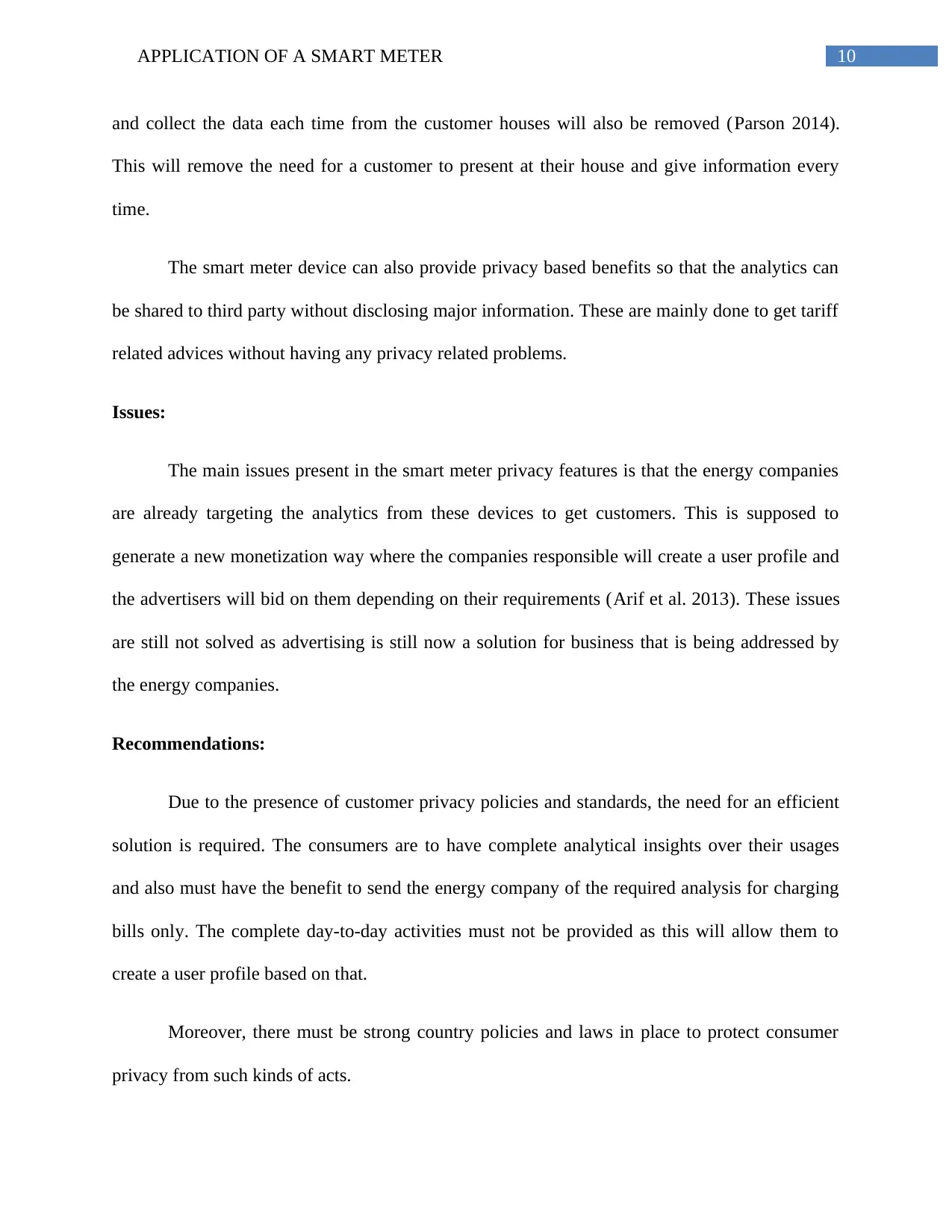
10APPLICATION OF A SMART METER
and collect the data each time from the customer houses will also be removed (Parson 2014).
This will remove the need for a customer to present at their house and give information every
time.
The smart meter device can also provide privacy based benefits so that the analytics can
be shared to third party without disclosing major information. These are mainly done to get tariff
related advices without having any privacy related problems.
Issues:
The main issues present in the smart meter privacy features is that the energy companies
are already targeting the analytics from these devices to get customers. This is supposed to
generate a new monetization way where the companies responsible will create a user profile and
the advertisers will bid on them depending on their requirements (Arif et al. 2013). These issues
are still not solved as advertising is still now a solution for business that is being addressed by
the energy companies.
Recommendations:
Due to the presence of customer privacy policies and standards, the need for an efficient
solution is required. The consumers are to have complete analytical insights over their usages
and also must have the benefit to send the energy company of the required analysis for charging
bills only. The complete day-to-day activities must not be provided as this will allow them to
create a user profile based on that.
Moreover, there must be strong country policies and laws in place to protect consumer
privacy from such kinds of acts.
and collect the data each time from the customer houses will also be removed (Parson 2014).
This will remove the need for a customer to present at their house and give information every
time.
The smart meter device can also provide privacy based benefits so that the analytics can
be shared to third party without disclosing major information. These are mainly done to get tariff
related advices without having any privacy related problems.
Issues:
The main issues present in the smart meter privacy features is that the energy companies
are already targeting the analytics from these devices to get customers. This is supposed to
generate a new monetization way where the companies responsible will create a user profile and
the advertisers will bid on them depending on their requirements (Arif et al. 2013). These issues
are still not solved as advertising is still now a solution for business that is being addressed by
the energy companies.
Recommendations:
Due to the presence of customer privacy policies and standards, the need for an efficient
solution is required. The consumers are to have complete analytical insights over their usages
and also must have the benefit to send the energy company of the required analysis for charging
bills only. The complete day-to-day activities must not be provided as this will allow them to
create a user profile based on that.
Moreover, there must be strong country policies and laws in place to protect consumer
privacy from such kinds of acts.
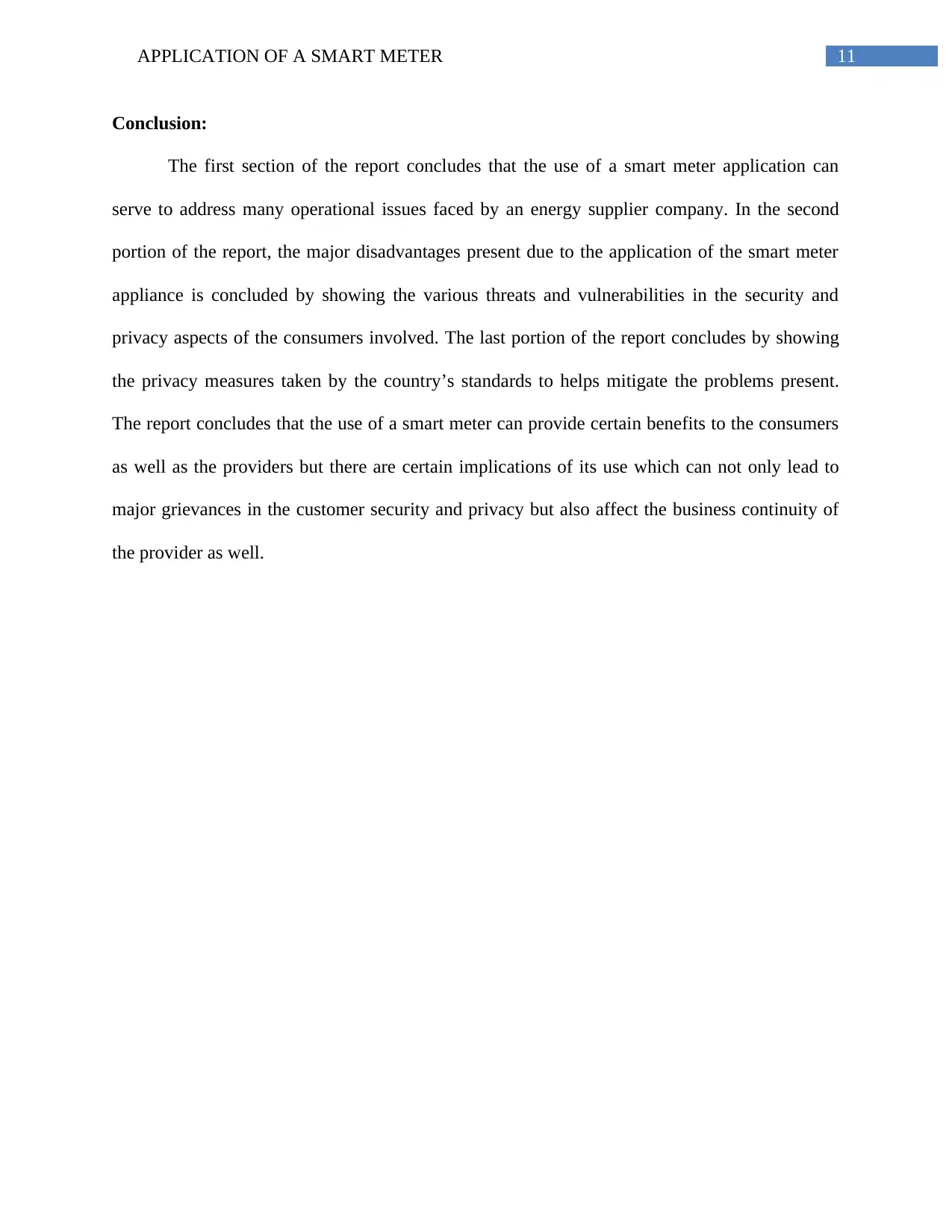
11APPLICATION OF A SMART METER
Conclusion:
The first section of the report concludes that the use of a smart meter application can
serve to address many operational issues faced by an energy supplier company. In the second
portion of the report, the major disadvantages present due to the application of the smart meter
appliance is concluded by showing the various threats and vulnerabilities in the security and
privacy aspects of the consumers involved. The last portion of the report concludes by showing
the privacy measures taken by the country’s standards to helps mitigate the problems present.
The report concludes that the use of a smart meter can provide certain benefits to the consumers
as well as the providers but there are certain implications of its use which can not only lead to
major grievances in the customer security and privacy but also affect the business continuity of
the provider as well.
Conclusion:
The first section of the report concludes that the use of a smart meter application can
serve to address many operational issues faced by an energy supplier company. In the second
portion of the report, the major disadvantages present due to the application of the smart meter
appliance is concluded by showing the various threats and vulnerabilities in the security and
privacy aspects of the consumers involved. The last portion of the report concludes by showing
the privacy measures taken by the country’s standards to helps mitigate the problems present.
The report concludes that the use of a smart meter can provide certain benefits to the consumers
as well as the providers but there are certain implications of its use which can not only lead to
major grievances in the customer security and privacy but also affect the business continuity of
the provider as well.
⊘ This is a preview!⊘
Do you want full access?
Subscribe today to unlock all pages.

Trusted by 1+ million students worldwide
1 out of 15
Related Documents
Your All-in-One AI-Powered Toolkit for Academic Success.
+13062052269
info@desklib.com
Available 24*7 on WhatsApp / Email
![[object Object]](/_next/static/media/star-bottom.7253800d.svg)
Unlock your academic potential
Copyright © 2020–2025 A2Z Services. All Rights Reserved. Developed and managed by ZUCOL.




